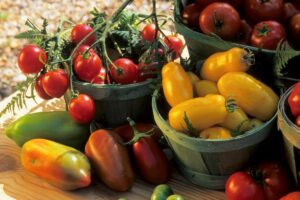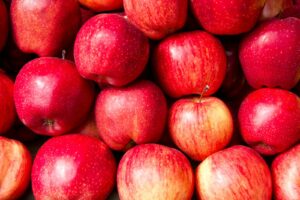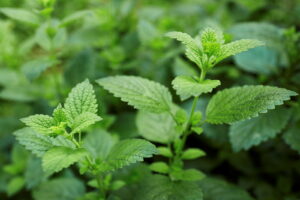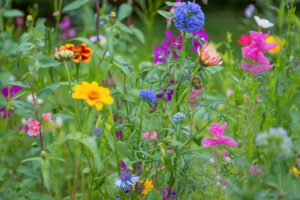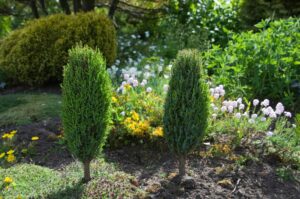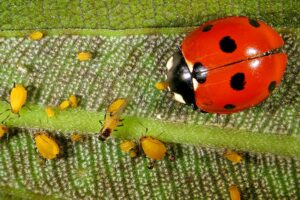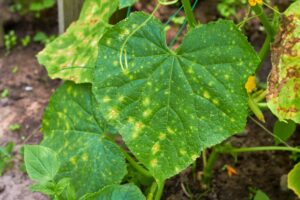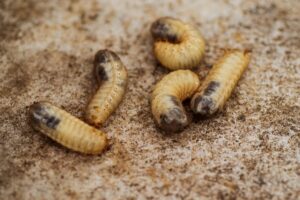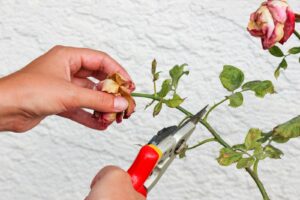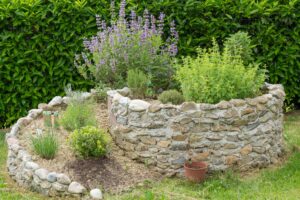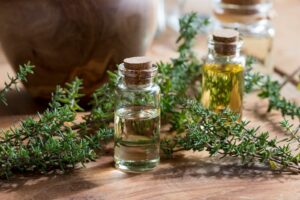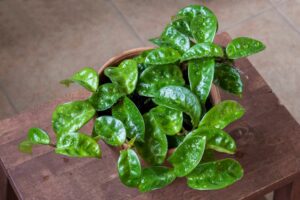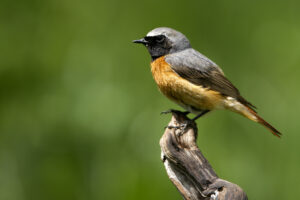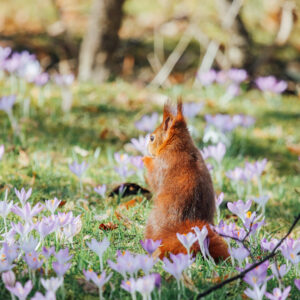Jacob’s ladder: planting, pruning & winter hardiness
Jacob’s ladder is a classic cottage garden plant with delightful sky-blue, dense flower panicles.

The endangered Jacob’s ladder (Polemonium caeruleum) occurs in nature in river valleys, wet meadows and floodplains. If a suitable location is chosen in the garden, planting Jacob’s ladder is perfectly possible even for beginners. We explain here what you should consider for successful planting and present the most beautiful varieties.
Contents
Jacob’s ladder: origin and characteristics
Polemonium caeruleum belongs to the Polemoniaceae family and is widespread throughout Central Europe as far as Western Siberia. Since the native Jacob’s ladder prefers moist sites and these habitats are increasingly dwindling, the plant is now considered endangered. In the garden, it is very suitable in flower beds and along the edges of woody plants or ponds with fresh to moist soils.

Jacob’s ladder or stairway to heaven is a deciduous perennial that grows up to 80 cm tall and bears pinnate leaves that resemble a ladder. Both names refer to a biblical story about Jacob’s ascent to heaven. This perennial is also known as Greek valerian and stairway to heaven. The sky-blue Jacob’s Ladder flowers stand in upright panicles and appear from June to July. Some varieties have white flowers. For bees and other insects, planting Jacob’s ladder is also a great joy, because the perennial offers plenty of nectar and pollen. Its flowerheads develop into numerous capsule fruits that open when ripe, releasing the seeds, which scatter and germinate quickly under the right conditions.
Tip: Suitable plant neighbours include meadowsweet (Filipendula), purple loosestrife (Lythrum salicaria), Siberian iris (Iris sibirica), great burnet (Sanguisorba officinalis).
Is Jacob’s ladder perennial? Yes, Jacob’s ladder is a perennial, although individual plants are short-lived. However, with occasional division and a watchful eye on the seedlings, they can be admired in the garden every year.

The most beautiful varieties
Commercially available varieties differ in their flower colour and growth height. We have put together the most beautiful ones for you.
- ‘Album’ is very similar to the wild form, but has pure white flowers from June to July and grows up to 60 cm tall.

- ‘Hopleys’ has stunning light purple and fragrant flowers that appear from May to July. Unlike the wild variety, ‘Hopleys’ does not seed itself.
- Polemonium caeruleum var. villosum is not a cultivar, but a variation that stands out for its intense floral fragrance. The flowers appear from June/July to September in a light purple to light blue colour. This perennial grows between 30 and 40 cm tall and should be planted 35 cm apart.

- ‘Brise d’Anjou’ bears medium blue flowers from June to July and grows up to 70 cm tall. The leaves have a cream-coloured edge.
- ‘Lambrook Mauve’ is a pink-flowering variety from England and adds an English cottage charm to the garden. It grows up to 50 cm tall and flowers in May, and again in September if pruned. Lambrook Mauve’ is a sterile hybrid and therefore does not form seeds.

Tip: The genus Polemonium has other pretty species to offer, such as the creeping Jacob’s ladder (Polemonium reptans), which grows a manageable 40 cm tall.

Planting Jacob’s ladder
Jacob’s ladder enriches sunny to semi-shady locations and is suitable for perennial beds, borders, wooded areas and pond edges. Dry, excessively hot places are not tolerated and reduce the vitality of the perennial considerably. The soil should be fresh to damp, permeable and rich in nutrients. Neutral to strongly alkaline soils are also preferred. If yours has a pH below 7 and is therefore acidic, we recommend applying a garden lime.
If you have found the ideal location, it is time to plant. Jacob’s ladder is available as a pre-cultivated perennial or in seed form.
- After the last late frosts in May, the seeds can be sown directly outdoors, while indoors, you can grow from seed as early as February to March.
- To do this, take a sowing tray or seed pots
- and fill with substrate. We recommend using a special growing soil, such as our peat-free Plantura Organic Herb & Seedling Compost This soil is lower in nutrients than conventional potting soil and thus promotes the root formation of the seedlings.
- It is best to press one seed per seed pot onto the substrate or cover it very thinly.
- If sown directly in the open ground, a distance of 40 – 50 cm should be maintained.
- Place the propagator in a bright place, the optimum germination temperature is 16 – 18 °C.
- If sowing is successful, you can expect to see seedlings after approx. 2 weeks.
- If they have been grown indoors, the young plants should be planted in a suitable location after the late frosts.

- Perfect for herbs as well as sowing, propagating & transplanting
- For aromatic herbs & healthy seedlings with strong roots
- Peat-free & organic soil: CO2-saving composition
Pre-cultivated perennials can be planted in the frost-free months. We recommend spring to be able to admire the flowers in the same year and to give the perennial enough time to establish itself before winter arrives. If there is any risk of waterlogging in the chosen location, a drainage layer of gravel or grit should be laid. Then plant Jacob’s ladder deep enough so that the lower leaves are above ground. Finally, press down the topsoil and water the freshly planted perennial generously.
Tip: Jacob’s ladder is particularly beautiful when planted in small groups of between 3 and 10 other specimens.

Jacob’s ladder not only decorates gardens, but can also be placed in planters on balconies and terraces. Choose a pot that offers the perennial enough space of at least 10 cm to the edge, depending on the size of the plant, and has a water drainage hole. If the plant becomes too big for the container, it should be divided and repotted. The substrate should be well-drained, rich in nutrients and structurally stable. Our peat-free Plantura Organic Flower Compost, for example, contains expanded clay, which provides a permeable and loose structure and thus counteracts unwanted waterlogging.
Tip: Polemonium caeruleum makes a wonderful cut flower and, depending on the variety, gives off a lovely fragrance.
The right care
Caring properly for Jacob’s ladder is not difficult provided you bear certain points in mind. As can be deduced from the site requirements, Jacob’s ladder has a relatively high water requirement. If you anticipate dry and hot summer days, you will need to give your plants extra water. The soil should be evenly fresh to moist. Pruning is not absolutely necessary but if Jacob’s ladder is pruned back close to the ground after flowering, it will prevent heavy seeding and encourage a second flowering in the same year.

To keep the perennial vigorous, it is advisable to divide it every 2 to 3 years. This involves carefully digging up the plant and dividing the rhizomes, i.e. the thickened shoot axes and at the same time storage organs. Make sure that the cuttings have enough roots to sprout later. Use a sharp and clean knife for this and plant the individual perennials separately at a distance of 40 to 50 cm.
For plants in containers we recommend additional fertiliser applications with mainly organic fertiliser. Our Plantura Liquid Flower Food, for example, can be conveniently added to the irrigation water and provides Jacob’s ladder with sufficient nutrients for the plant to produce a lush display of flowers.

- Perfect for all flowers & balcony plants
- Liquid fertiliser for a lush blossom throughout the season
- Quick & easy application - child & pet friendly
Is Jacob’s ladder hardy?
Jacob’s ladder is hardy down to low temperatures of -45 °C and does not require any special overwintering. Plants in containers, on the other hand, should be placed against the house wall and wrapped in jute or fleece until the last frosts in spring.
Propagation
In addition to the division of the rhizomes already described, which serves not only for rejuvenation but also for propagation, Jacob’s ladder can be propagated via its seeds. In this case, you will naturally need a variety that produces seeds. In the wild variety Polemonium caeruleum for example, the capsule fruits can be harvested shortly before ripening, i.e. before they are fully open. Use a sheet of paper as a base to catch the seeds when picking the fruit. The seeds are then stored in a cool, dry and dark place and either brought forward next spring or sown outdoors from May onwards.

Is Jacob’s ladder poisonous?
No, Jacob’s ladder is not poisonous, neither for pets nor for us humans. In ancient Greece, the rhizome was supposedly used as a remedy for dysentery, toothache and various animal bites. In today’s medicine, however, Polemonium caeruleum has no significance. Up to now, there have been no conclusive studies that prove any healing effect of the plant, which is why consumption of the ornamental plant is not recommended.
